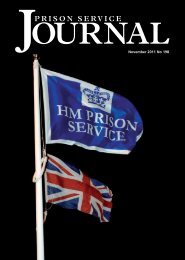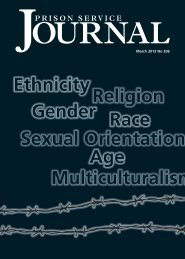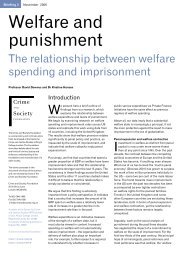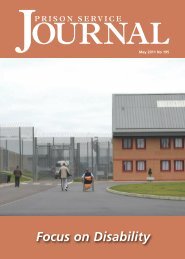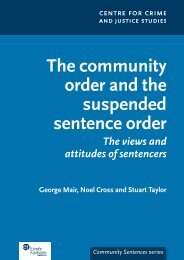PRISON SERVICE
PRISON SERVICE
PRISON SERVICE
- No tags were found...
Create successful ePaper yourself
Turn your PDF publications into a flip-book with our unique Google optimized e-Paper software.
CHART 9Changes in HCR-20 Scores after Treatment(Lower scores showing Improvement)65Number ofPrisoners4321First HCR-20Last HCR-20017-19 20-22 23-25 26-28 27-29 32-34 >35Scoresviolence risk assessment scheme intended for use inforensic psychiatric, civil psychiatric, and prisoninstitutional and community settings. Its purpose is tostructure clinical decisions about the likelihood ofviolent behaviour. The HCR-20 provides significantlyimproved valid predictions over previous testingmethods. The HCR-20 is an example of a StructuredProfessional Judgment (SPJ) risk assessment instrument.Clinicians gathers qualitative information about theperson being assessed, guided by the HCR-20, and theresults are used to make treatment decisions. Whilst thehistorical factors cannot change, the clinical and riskfactors can change; the lower the score the lower therisk of violence. In a prospective study of 41 long-termsentenced offenders in two high-security prisons,Belfrage et al (2000) 6 found that the historical scale wasof little use for high-risk men, but that there was a highpredictive value for the clinical and risk managementscales. These two scales can provide more sensitivediscrimination for high-risk groups. Chart 9 indicatesthe change in HCR-20 scores over the period oftreatment on the unit of the 17 men that were able tobe assessed post treatment. All bar two men showedreduction in the clinical and risk scales on the HCR-20over the period of treatment.ProgressionAll men in the first cohort came to the unit fromdispersal prison or segregation. Of the 18 prisoners, 9were Cat A prisoners. Of those 9 men, 5 have beendecategorised, and another man had received localrecommendation for decategorisation and is awaitingthe decision of the Central Team. One man has goneto hospital for further treatment, one is waiting for aspecialist hospital place, and two will remain in thedispersal system. Six men have been moved to Cat Bestablishments and a further 5 are awaiting places atCat B prisoners. Two men are currently on medicalhold for physical health problems but they will beleaving the dispersal system. One man, who hadpreviously spent most of his sentence in segregationand who, just prior to coming onto the unit, could notbe unlocked without a Senior Officer and 6 officers,was discharged into the community at the end of hissentence where he has lived safely for more than 18months.Financial Saving By Treating These PrisonersMuch as been talked about the cost of a place ona DSPD unit. Prison DSPD places are far less costly thanhospital DSPD places but are also less costly thanplacing men regularly in segregation or in CloseSupervision Centres (CSCs) to which many of the menin this first cohort were destined had they not beenplaced on the unit. If these prisoners had not receivedtreatment the ongoing cost to the public would almostcertainly have included costs of replacing broken orburnt property, cost of staff time due to recovery frominjury and related stress, and cost of regularly movingthese prisoners as most prisons did not hold them forlong periods. Two of the group of 18 were on ‘laydown’.Although not a current prison practice, thesetwo Cat A men, prior to coming onto the unit, were6. Belfrage, H., Fransson, G., & Strand, S. (2000). Prediction of violence using the HCR-20: A prospective study in two maximum securitycorrectional institutions. The Journal of Forensic Psychiatry, 11, 167– 175.Issue 192 Prison Service Journal53



